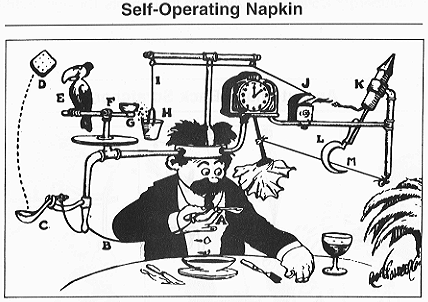Have you worked or do you work in an organization that follows one or many over-engineered process(es), commonly called the Rube Goldberg machines? For those who aren’t aware of the term Rube Goldberg machines, let me refer to Wikipedia to introduce Rube Goldberg and Rube Goldberg machine.
Rube Goldberg was an American cartoonist, sculptor, author, engineer, and inventor. Goldberg is best known for a series of popular cartoons depicting complicated gadgets that perform simple tasks in indirect, convoluted ways, giving rise to the term Rube Goldberg machines for any similar gadget or process.
A Rube Goldberg machine is a contraption, invention, device, or apparatus that is deliberately over-engineered to perform a simple task in a complicated fashion, generally including a chain reaction.

Rube Goldberg’s self-operating napkin. Rube Goldberg [Public domain], via Wikimedia Commons
The $8 million solution to an empty toothpaste boxes problem
A toothpaste factory had a problem. They sometimes shipped empty toothpaste boxes without the tube inside. This challenged their perceived quality with the buyers and distributors. Understanding how important the relationship with them was, the CEO of the company assembled his top people. They decided to hire an external engineering company to solve their empty boxes problem. The project followed the usual process: budget and project sponsor allocated, request for proposal (RFP), and third-parties selected. Six months and $8 million later they had a fantastic solution–on time, on budget, and high quality. Everyone in the project was pleased.
They solved the problem by using a high-tech precision scale that would sound a bell and flash lights whenever a toothpaste box weighed less than it should. The line would stop, someone would walk over, remove the defective box, and then press another button to restart the line. As a result of the new package monitoring process, no empty boxes were being shipped out of the factory.
With no more customer complaints, the CEO felt the $8 million was well spent. He then reviewed the line statistics report and discovered the number of empty boxes picked up by the scale in the first week was consistent with projections, however, the next three weeks were zero! The estimated rate should have been at least a dozen boxes a day. He had the engineers check the equipment; they verified the report as accurate.
Puzzled, the CEO traveled down to the factory, viewed the part of the line where the precision scale was installed, and observed just ahead of the new $8 million dollar solution sat a $20 desk fan blowing the empty boxes off the belt and into a bin. He asked the line supervisor what that was about. “Oh, that,” the supervisor replied, “Bert, the kid from maintenance, put it there because he was tired of walking over to restart the line every time the bell rang.”
In my case, the contractor time sheet approval process I had to follow was a Rube Goldberg machine. Here are the steps I had to take to make sure that the contractors working in my team got paid on time.
- Every Friday, the contractors would email me their time sheet. I had to approve their time sheets by responding to their email with the comment, “Approved”. They would, in turn, forward that email to the account representative in their parent company.
- The account representative of the vendor would then forward those time sheets to their contacts in the vendor management department of the hiring firm.
- Somebody in the vendor management department would, then, key in the information to a database.
- At the end of the month, I would get a bundle of time sheets belonging to the contractors in the team. I would then log into an ERP system to verify, one-by-one, that there is no discrepancy between the information registered in the system and the printout of the time sheets.
- Then, I’d have to approve the time sheets in the ERP system.
- Following that, I’d have to sign the printouts to confirm that I had verified the information.
- Next, I’d have to use the office mail to send the signed time sheets to the team responsible for vendor management.
- That particular team would then scan and upload those time sheets to the database and notify the finance department that everything’s A-OK.
- Finance would then give it one last look before giving the “go-ahead”.
- Finally, payments would be released to the approved vendors.
Think about it, for a second, somebody, somewhere in the company got paid to come up with that process. I was the first one to ask, “Can’t we streamline the entire process?”, while everybody around me was following it without asking any questions. However, my question and recommendation fell on deaf ears, of course.
How many of you have similar Rube Goldberg machines or systems in your organization that you have to follow and have to do so without asking any questions? I’d be curious to know.
